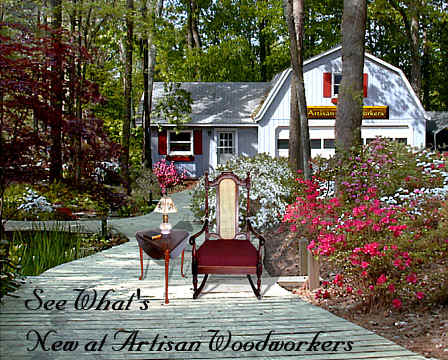
Glossary of Terms,
Antique Furniture
A
Acanthus:
Classic Greek and Roman ornamentation based on conventionalized leaf of acanthus
plant which grows in Asia Minor.
Acorn Turning:
Ornament resembling an acorn;
used as finials on chair and bed posts, as pendants, and as feet in table legs.
Characteristic of Jacobean furniture.
Adam:
Furniture designed the brothers Adam, Robert, and James, 18th Century English
architects-designers, in the same Pompeian classicism that earmarked their
houses. Slim, straight-line pieces were delicate and simple;
ornamentation, rich, yet restrained. Early work was in mahogany;
later in satinwood and hardwood with much painted decoration.
Adelphi:
A trade name adopted by the Brothers Adam.
American Colonial:
Any American furniture made or used in the Colonies before the Revolution. Early
pieces, favored by the Puritans, were purely utilitarian;
simplified, undecorated versions of Jacobean. Later furniture, reflecting
growing prosperity, consisted of more decorative, refined designs based on
English styles.
Antiques:
A term loosely applied to all old furniture. It should be confined to periods
ending with Sheraton's style in Europe and with Duncan Phyfe's in America.
Apothecary Chest:
Simple, straight-lined chest with multismall drawers;
originally used by professional apothecaries. Now offered in wide variety of
sizes for small storage items.
Applique:
A term given to applied ornament, such as carvings, turnings, lozenges, etc.,
which are tacked or glued to a surface rather than cut from the solid wood.
Apron:
A narrow strip of wood, or shaped element, such as the horizontal cross member
under a table top, chair seat, or lowboy.
Arabesque:
A saracenic form of ornament, usually composed of naturalistic ornament twined
about a rod or stem. Orginally as employed by Mohammedan designers, no animals
were ever represented in an arabesque. The motifs were resticted to flowers,
foliage, fruits, and figures of geometric design.
Armoire:
Tall wardrobe probably derivative of armor storage cabinets, often ornately
carved or painted.
Arm Pad:
The upholstered part of a chair arm.
Arm Stump:
The front vertical support of the arm of a chair.
Arrow Spindle:
Flattened spindle suggesting an arrow, used in 18th Century English or Early
American furniture ( backs of beds, chairs, settees)
Art Moderne:
French term for the various schools of contempory design, used in America during
the 1920's to label the earliest modern work.
Art Noveau:
French for "new art". Term refers to late 19th Century style which sprang from a
revived interest in the decorative arts;
a style that broke away from cliches. Based on natural growing forms ( like
curving, twisting trees trunks and branches);
its formula was the whiplash curve.
Arts and Crafts
Movement: A
revival of interest in the decorative arts in England which began about 1875
and, by 1884, grew to a definite revolt against tasteless overmechanization. The
ideal was the personal craftmanship in the Middle Ages. The mission style was
essentially an offshoot of the movement in America. The furniture forms are
simple and crude;
in their joinery concepts, rudimentary.

